The Florida I Love |
ďIf there can be such a thing as instinctual memory, the consciousness of land and water must lie deeper in the core of us than any knowledge of our fellow beings. We were bred of the earth before we were born of our mothers. Once born, we can live without our mothers or our fathers or any other kin or friend, or even human love. We cannot live without the earth or apart from it, and something is shriveled in manís heart when he turns away from it and concerns himself only with the affairs of men.Ē - Marjorie Kinnan Rawlings from Cross Creek
Mention the word Florida to most non-Floridians and what comes to mind is either the self-indulgent South Beach scene, with its self absorbed, spoiled rich throng of hedonists, or they think of a certain round-eared rodent that resides with its pals at Disneyworld. However, thereís still a very natural Florida that has managed to survive the onslaught of development and tourism. This is the Florida I love; the same Florida that holds me captive with its primitive charm and beauty. The Florida that had a magnetic pull on the first Spaniards that visited here. The Florida where magical crystalline springs boil up from the earth to form gin clear pools and streams that flow through jungle like terrain, and where mood soaked swamps conjure up thoughts of prehistoric time and the modern day dinosaurs that still call them home. The Florida which is full of coastal marshes that are rich in beauty and history and, of course, the sugar white sandy beaches of northwest Florida. This is the very same Florida Marjorie Kinnan Rawlings spoke so lovingly of and eloquently about in her novels and articles.
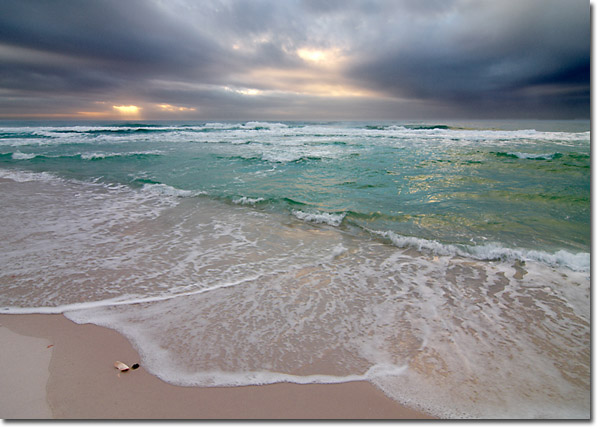
Todayís natural Florida can be a nature photographerís dream, but it doesnít always give up its beauty so easily. The same elements that made Florida tough for the Spaniards to conquer still plague the nature photographer Ė mosquitoes, biting gnats, no see-ums, red bugs, oppressive heat and humidity, and impossibly thick terrain can all work against you, but the rewards can be wonderful and fulfilling. Thereís a certain primeval feeling that comes across me when Iím part of this wilderness that makes me wish I could have seen this gorgeous country before manís ruthless hand touched it. Of course, that can be said for any location and any country, but I think itís especially true when a land has been so overly developed and damaged. When I do find those special places, those sanctuaries that still retain their original ďfeelĒ of yesteryear, I rejoice and consciously soak in the peace of that moment. The serenity of walking barefoot on cool sand, of hearing the gurgle of spring water as it escapes its underground lair and seeks the freedom of a swiftly flowing stream, the unmistakable dank aroma of the swamp, and the sound of wind blowing through the pines and cypress. The quest to capture those sights, sounds, and fragrances offers a wonderful challenge for the photographer. Snapping a picture is easy, but capturing an emotion or sense can be frustratingly difficult at times, but oh so gratifying when you actually achieve it. Failing to accomplish that goal makes me feel guilty, like Iíve somehow added to the harm the land has already suffered, making an irreverent statement that in some way insults the earth Iím trying to pay tribute to. Failure makes me part of the problem, just one more set of human footprints trampling down what was once pristine wilderness. The possibility of this failure provides impetus to try and improve photographic and compositional skills so failure hopefully occurs less and less, and the joy of success becomes more familiar.
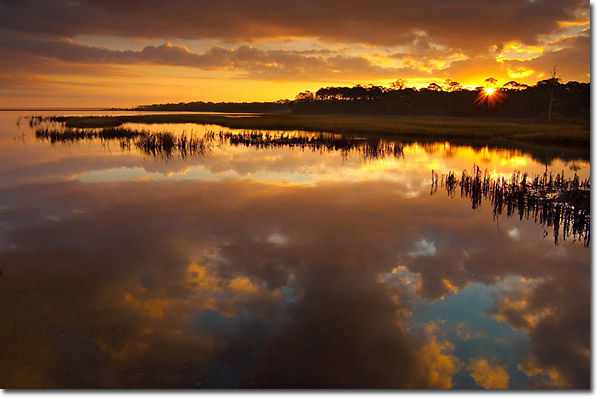
The Florida I love is about freedom. When Iím paddling my canoe down a stream or floating silently through a swamp at night, the feeling of freedom is tangible. It permeates my soul with emotion thatís as palpable as my pulse; billions of stars greet me, frogs serenade me, and the dew settles on me as it does on a blade of grass. When I trod through the bottomlands in winter, freedom is my companion. I can taste it in the chilled air and observe it as birds take wing and go tree to tree. The same is true when I visit the beach in October. A warm breeze awaits me there, as do the flowers that bloom each autumn on the dunes. The tourists have thankfully retreated by then and so often the only footprints I see among those dunes are mine, and I know they will disappear with the arrival of the next storm or windy day. Standing atop a small dune, peering out on the seemingly endless emerald colored water of the Gulf of Mexico I feel miniscule but exhilaratingly free. Is this how the first native Floridians felt long before it was called Florida? Can I capture this sense of freedom with a photographic image? Is that even possible?
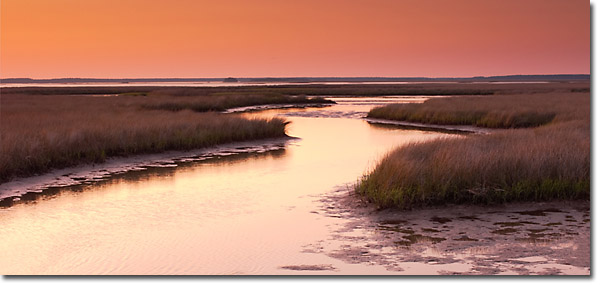
The Florida I love is about truth. Seeing how elements of nature are intertwined and work together. This isnít a rose colored glasses view of the world. Itís a survival of the fittest world in nature, but in the end, all things work out and fit in their niche. Sometimes this means images arenít necessarily pretty, but they represent the natural world accurately. Can I portray stark reality truthfully but still in an artistic fashion? Truth isnít always, or even most of the time, ugly however. Truth is also beautiful. New life blooming in the spring, the changing colors as cypress trees cross the threshold into autumn, and the playful fawn learning about itís new world. Few things are as pleasurable to me as sitting in my canoe enjoying the sights and sweet smells of spring as life bursts anew on one of Floridaís spring fed rivers. The same is true for autumn, except I prefer the tea colored, tannic stained water of the bottomland swamps and streams as the hues of autumn contrast and reflect so nicely against the dark color of the water. Florida offers the nature photographer such a vast array of opportunities to render the natural world in an accurate fashion. Does that mean my depiction is always faithful to what I observed? Well, yes and no. Itís truthful as to what the lens ďseesĒ, but so often whatís directly off camera is another truth altogether. How many times are my nature scenes squeezed in between the reality of development? How about the road in back of me that the viewer of my work never sees; the pristine beach scenes with a condo only a mile or two away. Hardly wilderness, but I suspect many of us are guilty of the same thing. Itís the truth we wish existed.
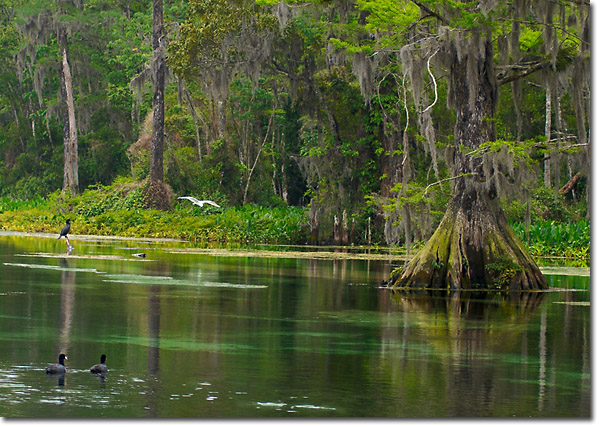
The Florida I love is about choices. These are personal and societal choices. Choices that go beyond what aperture and shutter speed to use. Choices about respect, honor, and responsibility, and about how I choose to live. Can I actively live in harmony and respect within this natural world and, if not, how can I expect to share the experience and emotion with others through my images? Do I live in such a way as to reduce my impact upon an already pressured landscape? Do my images encourage people to venture forth and put even more pressure on the earth? If so, are they responsible stewards of the land as well? On a larger scale, what about the choices of society? Florida, more than most, has been the victim of thoughtless and poorly planned development and decisions. Does Florida really need one more theme park, or another condominium? Places that just a few years ago were considered safe from development are now subject to that risk, making it more important than ever to record the natural areas before they disappear or become commercialized. If we, as a society, make the correct choices however, we can look forward to future generations enjoying our natural wonders for years to come. The good news is that I see progress being made; more slowly than I would like perhaps, but progress still. We have to remain vigilant, but I refuse to believe the situation is hopeless. The public consciousness seems to be swinging toward more responsible actions and reactions than at any time in my lifetime. Do negatives exist? Of course, many of them, and we shouldnít lose sight of them, but neither should we allow the sirens of negativity to lure us upon its rocky shore. Instead, those negatives will hopefully prod us into action; positive action that will preserve this amazing natural wonderland. Speaking for me, if I can turn my emotions into actions that will enthuse and encourage others to join the positive chorus, how much better will my little piece of the planet be? Seeing others push a positive agenda for protecting Floridaís natural environment fills me with hope and appreciation, and reaffirms that I can make a difference.
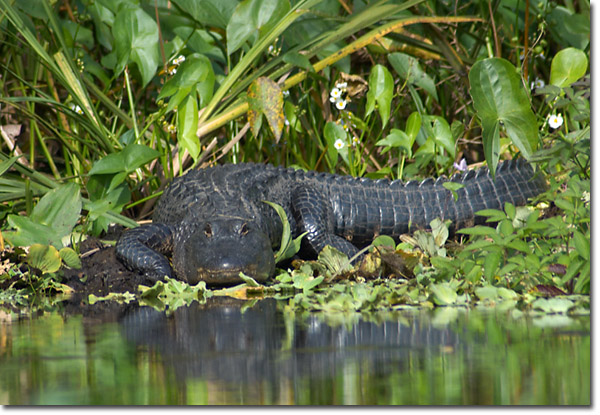
Finally, the Florida I love is about community. In this instance Iíll only concern myself with the photographic community. Where I live and shoot, I seldom cross paths with another photographer, and thatís the way I enjoy and prefer it. Iím naturally shy and anti-social to a large extent, but I do stay in touch with other photographers through NPN, email, and by phone. Iím constantly encouraged by the general tone and attitude I see and experience. On the whole, I have observed photographers making a positive impression, and Iím proud to consider myself part of that community, both here in Florida, and worldwide. Yes, I love Florida. The contentment I derive from this soil and water is both real and physical, and brings to mind a morsel from another Floridian who is one of my favorite authors and whose love for this land has inspired me for years.
"I do not understand how anyone can live without some small place of enchantment to turn to." ó Marjorie Kinnan Rawlings
Comments on NPN nature photography articles? Send them to the editor. NPN members may also log in and leave their comments below.
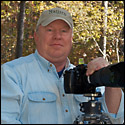 Bill Chambers is primarily a landscape photographer based in Gulf Breeze, Florida. He enjoys shooting the swamps and marshes of northwest and north central Florida, as well the beaches where he lives. His work is exhibited in local galleries and establishments in Florida and Alabama. To see more of his images please visit www.enchantedlightphotography.com.
Bill Chambers is primarily a landscape photographer based in Gulf Breeze, Florida. He enjoys shooting the swamps and marshes of northwest and north central Florida, as well the beaches where he lives. His work is exhibited in local galleries and establishments in Florida and Alabama. To see more of his images please visit www.enchantedlightphotography.com.